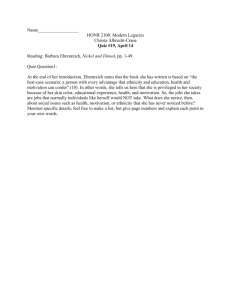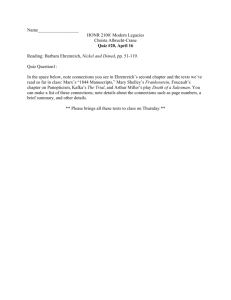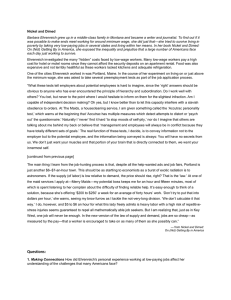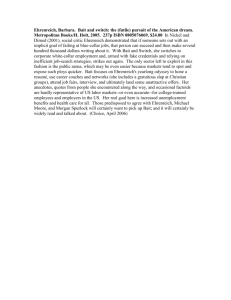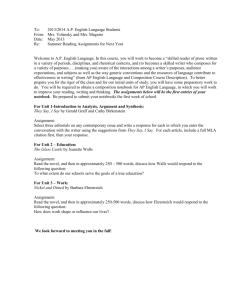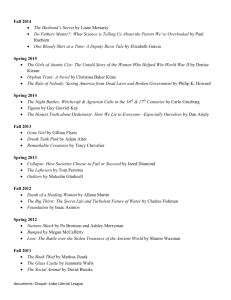ickel and Dimed Reading Questions
advertisement
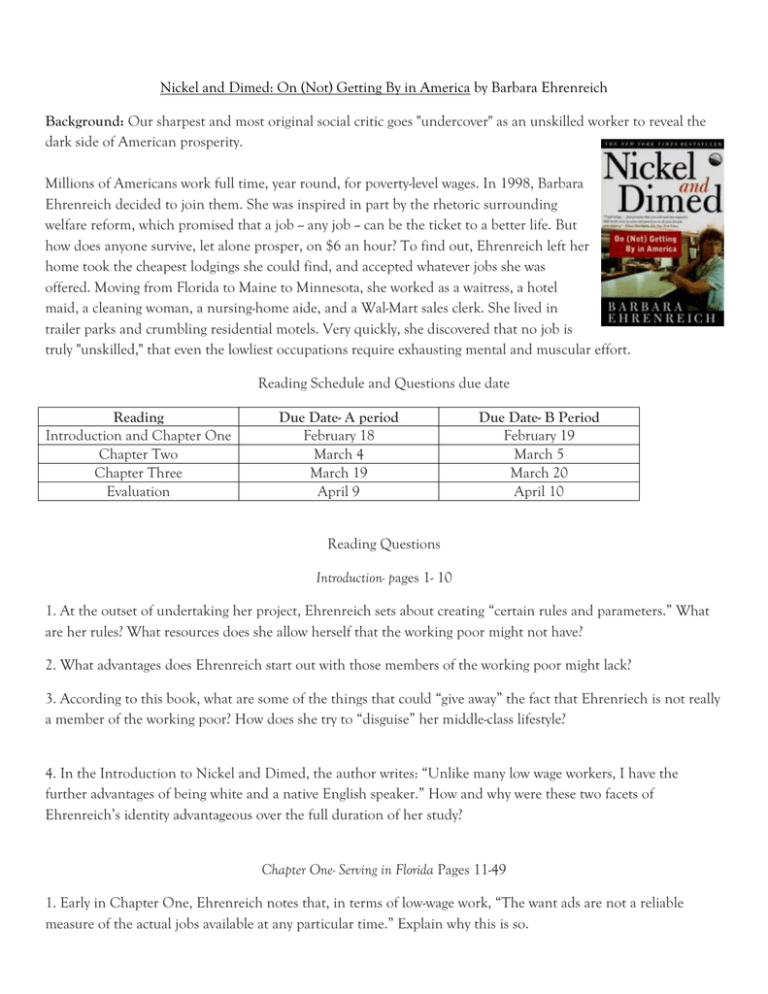
Nickel and Dimed: On (Not) Getting By in America by Barbara Ehrenreich Background: Our sharpest and most original social critic goes "undercover" as an unskilled worker to reveal the dark side of American prosperity. Millions of Americans work full time, year round, for poverty-level wages. In 1998, Barbara Ehrenreich decided to join them. She was inspired in part by the rhetoric surrounding welfare reform, which promised that a job -- any job -- can be the ticket to a better life. But how does anyone survive, let alone prosper, on $6 an hour? To find out, Ehrenreich left her home took the cheapest lodgings she could find, and accepted whatever jobs she was offered. Moving from Florida to Maine to Minnesota, she worked as a waitress, a hotel maid, a cleaning woman, a nursing-home aide, and a Wal-Mart sales clerk. She lived in trailer parks and crumbling residential motels. Very quickly, she discovered that no job is truly "unskilled," that even the lowliest occupations require exhausting mental and muscular effort. Reading Schedule and Questions due date Reading Introduction and Chapter One Chapter Two Chapter Three Evaluation Due Date- A period February 18 March 4 March 19 April 9 Due Date- B Period February 19 March 5 March 20 April 10 Reading Questions Introduction- pages 1- 10 1. At the outset of undertaking her project, Ehrenreich sets about creating “certain rules and parameters.” What are her rules? What resources does she allow herself that the working poor might not have? 2. What advantages does Ehrenreich start out with those members of the working poor might lack? 3. According to this book, what are some of the things that could “give away” the fact that Ehrenriech is not really a member of the working poor? How does she try to “disguise” her middle-class lifestyle? 4. In the Introduction to Nickel and Dimed, the author writes: “Unlike many low wage workers, I have the further advantages of being white and a native English speaker.” How and why were these two facets of Ehrenreich’s identity advantageous over the full duration of her study? Chapter One- Serving in Florida Pages 11-49 1. Early in Chapter One, Ehrenreich notes that, in terms of low-wage work, “The want ads are not a reliable measure of the actual jobs available at any particular time.” Explain why this is so. 2. On p. 17, the author talks about the touch-screen computer ordering system that she has to master. What other kinds of technology characterize the jobs of the working poor? How might these technologies be barriers to employment? 3. At one point, Ehrenreich details the living conditions of her fellow workers at the Hearthside. Reviewing these arrangements, explain how each set-up compares with the author’s own “$500 efficiency” quarters. 4. Waiting tables at Jerry’s, the author meets a young dishwasher named George. Who is he? What is his story? Why do he and Ehrenreich befriend one another? And why does she not “intervene” when she learns from an assistant manager that George is thought to be a thief? 5. On p. 22, Ehrenreich writes about her resentment of assistant managers, most of who are pulled out of the ranks of cooks and clerks. She says “everyone knows they have crossed over to the other side, which is crudely put, corporate, as opposed to human.” List three examples of inhumane behavior she experiences at the hands of managers while working in Florida. Why do you think people’s behavior changes when they rise to the management level? 6. In the footnote on p. 33, the author refers to a theory of “management by stress” where workers are “squeezed to extract maximum productivity to the detriment of their health.” List some examples of workplace illness described in this chapter. 7. Read the article entitled “Female Waitresses Endure Pervasive Harassment and Lower Wages, Says Report” How does this article echo the sentiment and experience of Ehrenreich? How is this article different than Ehrenreich’s experience? Chapter 2- Scrubbing in Maine Pages 51-119 1. Why is it so much more difficult to find a job if you are homeless? 2. On p. 57, Ehrenreich states that “Clerical work is ruled out by wardrobe limitations.” What other hourly jobs require a “business” wardrobe that is unavailable to the working poor? Where might one find affordable clothing in our community? 3. The author encounters yet another employer’s “personality test.’ She asserts that there is a hidden meaning in such tests: “The real function of these tests…is to convey information not to the employer but to the potential employee, and the information being conveyed is always: You have no secrets from us. We don’t just want your muscles and that portion of your brain that is directly connected to them; we want your innermost self? In your opinion, should potential employers have the right to demand that such a test be required of all applicants? How might an employer justify administering such a test? 4. During this part of the book, the author is forced to wear a uniform. How was she treated based on this uniform? What does it signify? 5. How does Ehrenreich characterize the typical cleaning job done by Merry Maids? How does this reflect the company’s attitude toward cleaning and toward its employees? 6. What dilemmas did her coworkers face with the following issues: housing, child care and health care? 7. On p.85, the author describes one homeowner’s complete lack of sympathy for Ehrenreich, who is on her hands and knees, scrubbing the floor. Why do you think this woman fails to identify with the worker? How does this connect with Ehrenreich’s later assertion that “Many of the owners seem hostile or contemptuous towards us” (p.100)? 8. The author discusses physical pain and injury and the attitude that one should “work through” pain. She describes laboring jobs where, over the course of a lifetime, people ruin their bodies. What impact did this job have on the people’s health? What impact could this have on them throughout their life? 9. The author describes the process she goes through in attempting to receive food assistance. How is she treated? What are the obstacles she encounters when trying to get help? How could social service agencies change in order to be more accommodating? 10. Looking back on Chapter Two as a whole, what connections would you make between maids and minorities in the United States? What about between maids and poverty, and maids and “invisibility”? Refer to the text itself when making your links. 11. Read the article entitled “The Invisible World of Domestic Work Report Documents Abuses” How does this article echo the sentiment and experience of Ehrenreich? How is this article different than Ehrenreich’s experience? Chapter Three: Selling in Minnesota pages 121-191 1. During her time in Minnesota what were some issues that she ran into housing wise? 2. Paraphrase the brief “story within a story” represented by the character called Caroline. What is Caroline’s tale? Why does Ehrenreich get in touch with this person, and what does she learn from her? 3. During her time in Minnesota, Ehrenreich explains her panic over the drug tests for her employers. Many people criticized her for this. What are your feelings on her actions? Why do you think employers test for drugs? Do you think it is effective or another hoop for the unemployed to jump through? Why or why not? 4. Describe her process of becoming a Wal-Mart employee. 5. What were some of the challenges that she and other employees faced working at Wal-Mart and surviving? 6. As her stint at Wal-Mart winds down, the author mentions to several of her colleagues that they “could use a union here”—only, as she herself readily admits, she is “not a union organizer any more than [she is] Wal-Mart ‘management material.’” So why, then, is she making efforts at unionizing? What has led her to these efforts? What are her reasons, grievances, motivations, and goals? 7. Read the article entitled “How Walmart’s Low Wages Cost All Americans, Not Just its Workers” How does this article echo the sentiment and experience of Ehrenreich? How is this article different than Ehrenreich’s experience? Evaluation pages 193-221 1. At the outset of her Evaluation chapter, the author seems to arrive at a new understanding of the phrase “unskilled labor.” Explain this new understanding. Do you agree with it? Why or why not? 2. Describe the problems that Ehrenreich has with how the “poverty level” is calculated in this country. Is she correct on this score, in your view? Explain. Also, how does one’s understanding of the poverty level—Ehrenreich’s or anyone else’s— relate to food costs, and to the author’s assertion that our “wages are too low and rents too high.” 3. What is the “money taboo”—and why and how does it function, as Ehrenreich puts it, “most effectively among the lowest-paid people”? 4. Why does Ehrenreich refer to low-wage workers, at the close of her book, as “the major philanthropists of our society”? 5. What did you learn about poverty while reading the book? What was the most interesting thing that you learned? Has your attitude towards those in poverty change? Why or why not? 6. Nickel and Dimed takes place during a so-called economic boom in American history, the period of “peace and prosperity” that was the late 1990s. However, the book is largely about poverty, about the poor—and not simply the helplessly destitute, but rather the poor who are employed full-time. Look at the stats given to you about poverty today- how would her book be different if written now? Nickel and Dimed project Due: April 9 (A) and April 10 (B) Pick one of the following projects to do: 1- Watch five different shows/movies that show a variety of different financial lifestyles. From this write a three to four page paper that analyzes what popular media is telling us about poverty. Consider answering the following questions in your paper: Does it ignore it? Gloss over poverty? Does it idolize the rich? Does it exaggerate what the common middle class family can own and do? What impact does that have on the viewer? What impact does that have on the discussion of poverty in the United States? 2- You are now a worker receiving minimum wage in North Carolina ($7.25). You are to find the following things using the internet, newspapers, own experience etc. Create a budget that will allow you to do the following: - Pay bills (electric, water/sewage, cable, phone etc.) - Pay rent - Pay for food - Pay for gas for your car - Other expenditures In your three page write up explain what difficulties you experienced in creating a budget and what challenges people living on minimum wage face. 3- Research what is happening in the United States and North Carolina in regards to unemployment benefits, food stamps and people in poverty. Pick five news articles that focus on these issues. Write a three- four page paper; the first part- summarizing what the articles said and second part- what impact you believe this will have on people in poverty in the United States. How would you fix the problems of poverty? 4- Interview two people that you know are affected by poverty with questions that you come up with. Write a three-four page paper on the information you learned from them about their life in poverty and the struggles that they face. Attach the list of questions to the paper.
